Towers in the Tempest
|
|
This visualization won Honorable Mention in the National Science Foundation's Science and Engineering Visualization Challenge in September 2007. 'Towers in the Tempest' is a 4.5 minute narrated animation that explains recent scientific insights into how hurricanes intensify. This intensification can be caused by a phenomenon called a 'hot tower'. For the first time, research meteorologists have run complex simulations using a very fine temporal resolution of 3 minutes. Combining this simulation data with satellite observations enables detailed study of 'hot towers'. The science of 'hot towers' is described using: observed hurricane data from a satellite, descriptive illustrations, and volumetric visualizations of simulation data. The first section of the animation shows actual data from Hurricane Bonnie observed by NASA's Tropical Rainfall Measuring Mission (TRMM) spacecraft. Three dimensional precipitation radar data reveal a strong 'hot tower' in Hurricane Bonnie's internal structure. The second section uses illustrations to show the dynamics of a hurricane and the formation of 'hot towers'. 'Hot towers' are formed as air spirals inward towards the eye and is forced rapidly upwards, accelerating the movement of energy into high altitude clouds. The third section shows these processes using volumetric cloud, wind, and vorticity data from a supercomputer simulation of Hurricane Bonnie. Vertical wind speed data highlights a 'hot tower'. Arrows representing the wind field move rapidly up into the 'hot tower, boosting the energy and intensifying the hurricane. Combining satellite observations with super-computer simulations provides a powerful tool for studying Earth's complex systems. The complete script is available here . The storyboard is available here . There is also a movie of storyboard drawings with narration below.
|
|
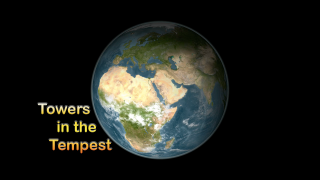
|
|
Towers in the Tempest - full narrated version
Duration: 4.3 minutes
Available formats:
1280x720 (30 fps)
MPEG-4
95 MB
640x360 (30 fps)
MPEG-4
49 MB
960x540 (30 fps)
MPEG-4
94 MB
512x288 (30 fps)
MPEG-1
73 MB
720x480 (30 fps)
MPEG-4
97 MB
1280x720 (60 fps)
MPEG-4
182 MB
1280x720 (59.94 fps)
Frames
1280x720
TIFF
550 KB
320x180
PNG
103 KB
Audio Track
How to play our movies
|
|
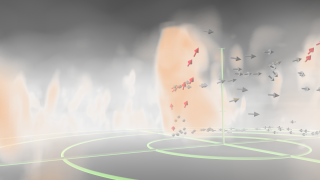
|
|
This animation combines the first two sections of the narrated piece above. It begins with NASA's fleet of satellites, shows observed data from the TRMM satellite, and then displays NCAR meoscale model data of Hurricane Bonnie.
Duration: 2.5 minutes
Available formats:
1280x720 (30 fps)
MPEG-4
50 MB
320x180
PNG
216 KB
1280x720 (30 fps)
Frames
640x480 (30 fps)
Frames
How to play our movies
|
|
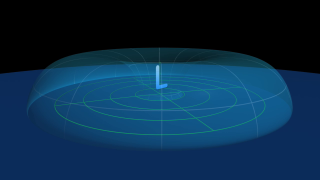
|
|
This is the section two of the full movie that explains the dynamics of wind and energy inside of a hurricane. This movie contains audio.
Duration: 1.5 minutes
Available formats:
1280x720 (60 fps)
MPEG-4
49 MB
320x180
PNG
69 KB
How to play our movies
|
|
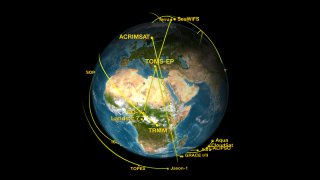
|
|
NASA's Earth observing fleet
Available formats:
3840 x 2160
TIFF
3 MB
320 x 180
PNG
93 KB
|
|
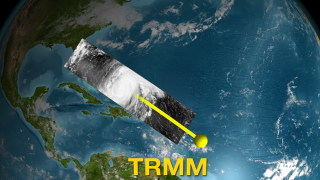
|
|
TRMM observes Hurricane Bonnie using the Visible and Infrared Sensor (VIRS)
Available formats:
3840 x 2160
TIFF
9 MB
320 x 180
PNG
295 KB
|
|
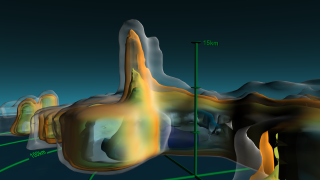
|
|
TRMM's precipitation radar (PR) data of Hurricane Bonnie
Available formats:
3840 x 2160
TIFF
5 MB
320 x 180
PNG
230 KB
|
|
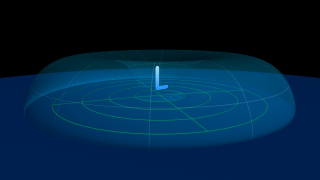
|
|
A hurricane's eye is an intense low pressure system
Available formats:
3840 x 2160
TIFF
2 MB
320 x 180
PNG
126 KB
|
|

|
|
Air spirals inward towards the eye, rapidly upward, and outward
Available formats:
3840 x 2160
TIFF
3 MB
320 x 180
PNG
188 KB
|
|
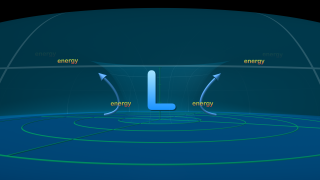
|
|
Air picks up energy from the warm ocean through evaporation and releases it in the hurricane through condensation
Available formats:
160 x 80
PNG
44 KB
3840 x 2160
TIFF
3 MB
320 x 180
PNG
176 KB
|
|
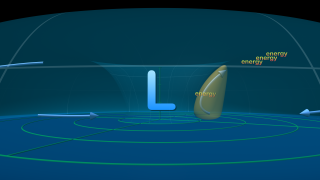
|
|
Hot towers act like 'express elevators', accelerating the movement of energy up into the hurricane
Available formats:
3840 x 2160
TIFF
3 MB
320 x 180
PNG
178 KB
|
|
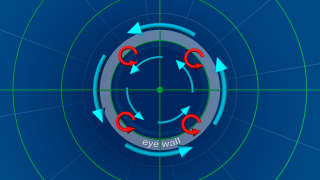
|
|
Wind speed changes between the fierce eye wall and relatively calm winds in the eye can spin up intense vortices
Available formats:
3840 x 2160
TIFF
5 MB
320 x 180
PNG
210 KB
|
|
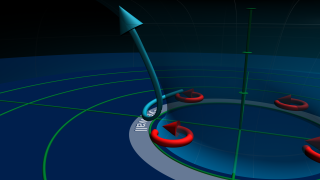
|
|
Near the surface, air spiraling inward collides with vortices, forcing the air upwards, creating an updraft
Available formats:
3840 x 2160
TIFF
4 MB
320 x 180
PNG
191 KB
|
|
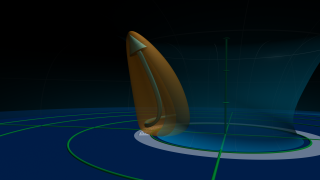
|
|
A very strong updraft moves energy much higher than normal, creating a hot tower
Available formats:
3840 x 2160
TIFF
3 MB
320 x 180
PNG
171 KB
|
|
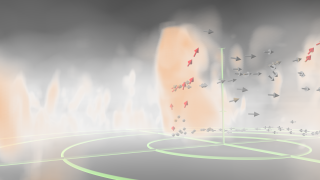
|
|
Step zero of the simulation shows the low level winds, represented as arrows, rising quickly in the updraft (orange region).
Available formats:
3840 x 2160
TIFF
11 MB
320 x 180
PNG
249 KB
|
|
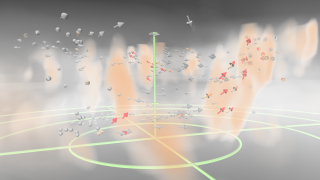
|
|
Fifteen minutes later, the updrafts (orange) have moved with the winds.
Notice the red arrows which show the low level winds caught in the storm's updrafts.
Available formats:
3840 x 2160
TIFF
12 MB
320 x 180
PNG
256 KB
|
|
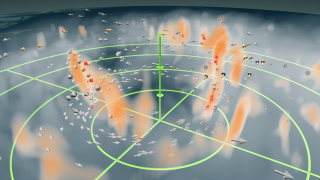
|
|
The winds and updrafts continue to change. The green circles are 50 km, 100 km, 150 km, and 200 km from the center of the simulation.
Available formats:
3840 x 2160
TIFF
17 MB
320 x 180
PNG
276 KB
|
|
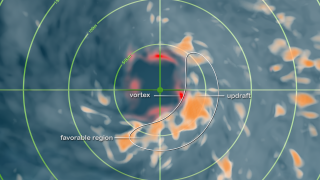
|
|
The favorable region for updraft formation and a vortex/updraft pair.
Available formats:
3840 x 2160
TIFF
16 MB
320 x 180
PNG
278 KB
|
|
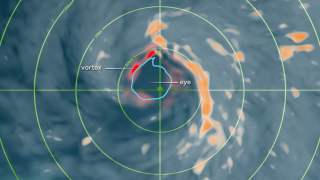
|
|
The eye of the storm is shown in blue and vorticity in red.
Available formats:
1280 x 720
TIFF
1 MB
320 x 180
PNG
268 KB
|
|
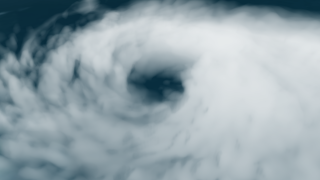
|
|
Volumetric clouds of Hurricane Bonnie only.
Available formats:
3840 x 2160
TIFF
13 MB
320 x 180
PNG
259 KB
|
|
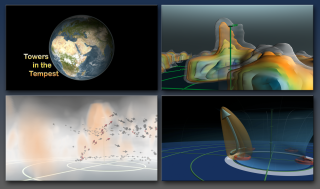
|
|
Composite still
Available formats:
2696 x 1594
TIFF
3 MB
320 x 189
PNG
238 KB
160 x 80
PNG
64 KB
80 x 40
PNG
25 KB
|
|

|
|
This animation is the video from section two of the full movie which illustrates the dynamics of a hurricane and the formation of Hot Towers.
Duration: 1.5 minutes
Available formats:
1280x720 (60 fps)
MPEG-4
47 MB
320x180
PNG
69 KB
How to play our movies
|
|
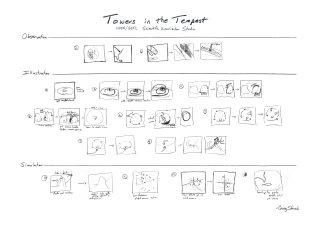
|
|
Storyboard composite based on original hand-drawn sketches (displayed at SIGGRAPH 2008)
Available formats:
16640 x 11840
TIFF
19 MB
2249 x 1546
JPEG
282 KB
320 x 227
PNG
121 KB
|
|
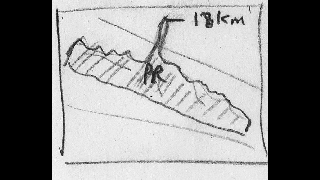
|
|
Storyboard version with hand-drawn still images
Duration: 4.3 minutes
Available formats:
320x180
PNG
28 KB
300x250 (60 fps)
MPEG-4
338 MB
How to play our movies
|
|
|
Back to Top
|